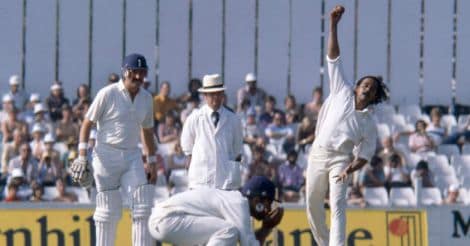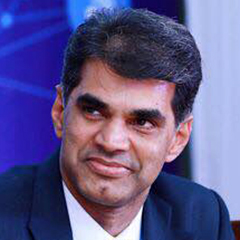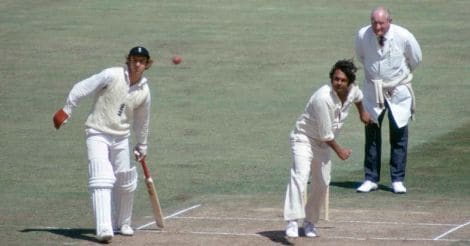A new era dawned in Indian cricket during the 1960s after Mansur Ali Khan Pataudi took over as skipper of the national side. During this period, he consolidated the team, gave his players the confidence that they were as good as their opponents and mentored the development of a quartet of world class spinners, who became the spearhead of the side. It is a matter of supreme irony that Pataudi was not at the helm when returns for this investment came in the form of three back-to-back series victories during the period between 1971 and 1973. But the four spinners, who matured under his guidance, served the cause of Indian cricket commendably till they faded away from the scene towards the end of 1970s and early years of the next decade.
Out of this quartet, one, Bishen Bedi, was a classical left-arm spinner, while another, Bhagawath Chandrasekhar (Chandra), was an unorthodox leg spin and googly bowler. The remaining two - Erapalli Prasanna and Srinivas Venkataraghavan - practised the same craft in that both were masters of the art of off-spin bowling. Though their bowling styles and methods adopted for taking wickets were different, the fact that both of them turned the ball in the same direction made them compete for the same slot in the playing eleven on many occasions.
Similarities
The similarities between these two maestros are many. Prasanna, the senior of the two, hailed from Mysore and made his first class debut in 1961. He soon graduated to to Test cricket and played for India against England at Chennai in 1962. He toured the West Indies with the national squad immediately thereafter and played in one Test, after which he took a sabbatical from the game to complete his studies to become an engineer. He returned to first class cricket in 1966 and made a comeback to the national squad in 1967. He took over the captaincy of Mysore (present day Karnataka) side in 1968 and led them to Ranji Trophy triumph in 1974, breaking the monopoly enjoyed by Mumbai for 15 years.
Venkataraghavan (Venkat) was born and brought up in the bylanes of Mylapore in Chennai and made his first class debut during the 1963-64 season. He first played for India in February, 1965, against the touring New Zealanders. In the fourth Test of that series, he made the cricketing world sit up and notice by snapping 8 wickets for 72 runs in the New Zealand first innings. He returned match figures of 12 wickets for 152 runs, helping India win the match and thereby secure the series. He became the captain of Madras (present day Tamil Nadu) side in 1969 and, like Prasanna, he was also a qualified engineer.
The return of Prasanna to the national squad in January, 1967, created a difficult situation for the selectors and the team management. Conventional wisdom decided that there could not be more than three spinners in the side. Since Chandra and Bedi were automatic choices given the nature of their bowling, the axe had to fall on either Prasanna or Venkat. Thus, during the 11 years till 1978, one finds that they were invariably competing for the same place in the side on most occasions. It was only during the 1968-71 period, when Chandra was out of the reckoning, did both of them play together. And there was only one occasion, against England at Edgbaston in 1967, when all four members of this quartet played together for the country in a Test.
Dream run
After his comeback, Prasanna enjoyed a glorious run between 1967 and 1970, when he was easily the best spin bowler in the world. Striking a good partnership with Bedi, he took on the role of an attacking bowler and picked up 100 wickets in only 16 Tests, all played against Australia and New Zealand. Venkat was reduced to playing the role of a supporting spinner during this phase.
But the wheel of fortune took a turn for the better for Venkat when he was appointed as deputy to captain Ajit Wadekar for the tour to the West Indies in 1971. He struck top form and emerged as the leading wicket-taker during that series. When Chandra returned to the side for the tour of England that followed, it was the turn of Prasanna to be dropped from the playing eleven. Venkat cemented his place in the side by providing the perfect foil for both Chandra and Bedi, keeping one end tight and picking up the occasional wicket.
Prasanna was too good a bowler to be left out of the team for long. He came back to the side in the second Test of the home series against England in 1972-73, and Venkat had to make way for him. After this, Prasanna became the first choice for the role of third spinner in the playing eleven and the only exception came during the tour to West Indies in 1976, when he lost form, prompting skipper Bedi to choose Venkat as the off spinner in the side. In between, Venkat led India in a Test, against the West Indies at Delhi in 1974, and also in the inaugural World Cup in 1975. Incidentally, after being the captaining India, Venkat found himself as the twelfth man carrying drinks in the next one! Zaheer Abbas and other Pakistani batsmen effectively wrote the epitaph on Prasanna’s career during the series in 1978 when they sent all the Indian spinners, except Venkat, who did not play in any of the Test matches, on a leather hunt.
Venkat automatically stepped into the role of lead spin bowler during the series against the West Indies in 1978-79, picking up 20 wickets. He was catapulted to the post of captain of the national side for the 1979 World Cup and the series against England that followed. India started disastrously losing all the three matches they played in the World Cup. However, in the Test series, after starting poorly and losing the first Test by a huge margin, India hit back strongly and came close to winning the last Test. Thus the team, though defeated, was not disgraced and Venkat could justifiably take pride in having presided over this transformation. But a huge shock awaited him when he was informed, on his return to India, that Sunil Gavaskar had replaced him as skipper of the side.
 Srinivas Venkataraghavan extracted turn and bounce because of his high arm action. Getty Images
Srinivas Venkataraghavan extracted turn and bounce because of his high arm action. Getty ImagesVenkat was dropped from the national squad after the third Test against Australia during the 1979 series played at home, to make way for Shivlal Yadav, a new off-spinner. He was recalled for the tour to the West Indies in 1983, probably on account of his success in the pitches there during the previous tours. However, he was only a shadow of his earlier self and played his last Test match against Pakistan when the latter toured India at the beginning of 1983-84 season.
Though they were both off-spinners, Prasanna and Venkat were completely different when it came to bowling styles. Prasanna was the master of the flight, who was always ready to toss the ball up to the batsmen, inviting them to hit him out of the ground. He planned his moves with the tactical intellect worthy of a chess Grandmaster, and often lulled the batsmen into a state of complacency before suddenly moving in for the kill. Though he could bowl a mean off break, he relied more on subtle variations of length, line and flight to pick up his wickets.
Venkat, on the other hand, delivered the ball from a greater height and hence extracted more turn and bounce. He probed on the defenses of the batsmen relentlessly, and rarely gave them the luxury of a loose delivery. He was a greater force on the hard and bouncy tracks in the West Indies, where his deliveries acquired a greater venom. In the beginning of his career he also possessed a sharp leg cutter, but this weapon disappeared from his repertoire later on.
Thus, it could be seen that it was extremely unfair to make Prasanna and Venkat compete for the same place in the playing eleven for most part of their careers. Either of them could have walked into any contemporary international side and held on to their places easily, given their potential and performances. It would remain a matter of misfortune to both Prasanna and Venkat as well as to Indian cricket that they were contemporaries who played at a time when India had an excess of riches in the spin bowling department.
Another interesting aspect that emerges on examining their career is that both of them were competent captains. Though Prasanna did not get an opportunity to lead the national side, he was respected as a shrewd and imaginative leader of men in domestic cricket and led Karnataka to two Ranji Trophy triumphs. Of the two, Venkat was definitely a better fielder, who stood at gully and took many a difficult catch; he had a better record as batsman too, both at first class and international level. Venkat also developed a well deserved reputation for being a tough taskmaster, who would not suffer fools, least of all flanneled fools, gladly, while Prasanna was known for his amicable and friendly disposition.
Both Prasanna and Venkat continued to associate themselves with the game long after their playing days were over. While Prasanna’s involvement was limited to being the manager of the Indian team on one occasion and a match referee (in the disbanded ICL) for a brief span, Venkat enjoyed a successful career in cricket after hanging up his playing shoes. He became secretary of Tamil Nadu Cricket Association for one tenure and was manager of the national squad during the tour to West Indies in 1989. He took up umpiring on a serious note in 1992 and, within a short span of time, emerged as one of the best in the game. He retained his position as one of the most respected and competent umpires in International Cricket Council (ICC)’s elite panel, till his retirement in 2005.
In the final analysis, it would be seen that both Prasanna and Venkat were master craftsmen who rendered yeoman service to Indian cricket. They played cricket during a period when financial returns it offered were little; despite this they chose to sacrifice their professional careers as engineers for the sake of the game. They had to undergo the disappointment and ignominy of being dropped from the national squad on multiple occasions, but they took them stoically, never allowing such instances to either alter their personality or diminish their passion for the game. They were disciplined and committed players, always letting their performances with the ball do the talking and never ventured to criticize a fellow player or administrators for the setbacks that they suffered. Above all, they had immense respect for each other and to the craft they practised.
Prasanna and Venkat are role models not only for the present lot of cricketers but to all those who find themselves being denied their worth and recognition at many points in their lives, despite possessing tons of talent and working sincerely to convert it into performance.
(The author is a former international umpire and a senior bureaucrat)

























 Erapalli Prasanna in action during the third Test against England at Edgbaston, Birmingham, on July 6, 1974. Getty Images
Erapalli Prasanna in action during the third Test against England at Edgbaston, Birmingham, on July 6, 1974. Getty Images
